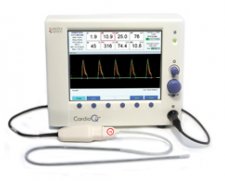
Categorised under:
Anaesthesia
>
Patient monitoring
>
Cardiac output monitors
The ODM has a flexible ultrasound transceiver probe (see photo) which is placed into the distal oesophagus via either nose (more stable positioning) or mouth. This is rotated until the best quality signal is achieved from blood flowing in the descending aorta. Peak velocity and flow time measurements allow derived calculations of cardiac output and other parameters to be made.
The ODM has a flexible ultrasound transceiver probe (see photo) which is placed into the distal oesophagus via either nose (more stable positioning) or mouth. This is rotated until the best quality signal is achieved from blood flowing in the descending aorta. Peak velocity and flow time measurements allow derived calculations of cardiac output and other parameters to be made.
The ODM is supplied as a stand alone box approximately 30x30x10cm, but is easily upgraded to a wheeled stand version for ease of use.
It has an easy to navigate front panel, using control wheel confirmation of commands.
It has real time display of Doppler wave forms and associated variables as well as a freeze screen and trend waveform. Displayed variables include peak velocity, flow times, calculated stroke volumes and cardiac output/index. Additional software allows oxygen delivery estimates to be made.
Information can be transferred to a printer or hard drive via standard COM ports.
The ODM is easy to use, with a relatively brief learning curve, and displayed results within a couple of minutes of starting in most patients.
It is less useful for patients with very irregular heart rates (although this can be partly overcome by changing the display averaging times). Also, it is of limited use for patients undergoing aortic surgery (due to cross-clamping) or for awake patients (the wire coils in the probe makes it uncomfortable at pharyngeal level- a persistent problem despite several probe upgrades and redesigns. Although diathermy interferes with the displayed signal (see video), this is usually a minor inconvenience only.
The published literature supports the use of ODM guided goal-directed therapy for reducing the morbidity associated with elective surgery. None of the studies carried out to date have been adequately powered to show mortality reductions. NICE are due to publish a report imminently on this device.
In critical care use, no well designed study has shown a mortality benefit from using any cardiac output monitor.
Weaknesses: Awake patients, occasionally difficulty focussing probe.
Ian Nesbitt, Anaesthesia & Critical Care Consultant, Newcastle upon Tyne, UK - No Conflict Declared.
Ian Nesbitt qualified from Newcastle upon Tyne Medical School, trained in the UK, Australia and New Zealand. He works as a consultant in the NHS in Anaesthesia & Critical Care. He is an advisor to NICE on technology (including ODM).

Did you know you can Register for FREE with this website?
Registration gives you full access to all of the features of WhichMedicalDevice. Find out more ...
WhichMedicalDevice is a FREE resource created by clinicians for clinicians.
Registration is free and gives you unlimited access to all of the content and features of this website.
Find out more...Registration is free and gives you unlimited access to all of the content and features of Which Medical Device. Find out more...
Which Medical Device is a community of clinicians sharing knowledge and experience of the devices and procedures we use on a daily basis. We ask that our members register with us so that we can maintain the unbiased and independent nature of our content. Registration is quick and free.
We do not make your details available to any third parties nor do we send unsolicited emails to our members. You can read our Privacy Policy here.